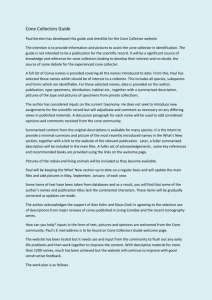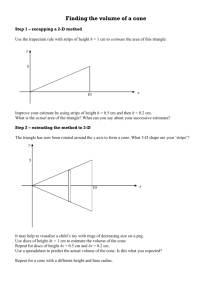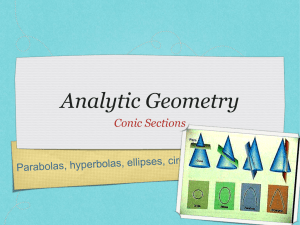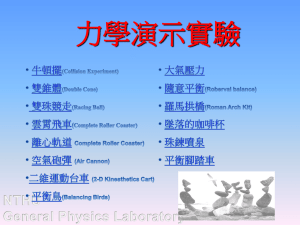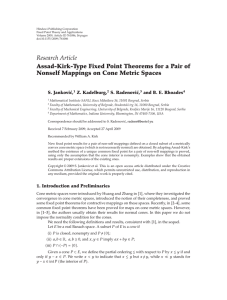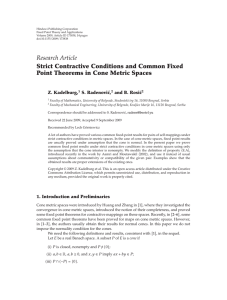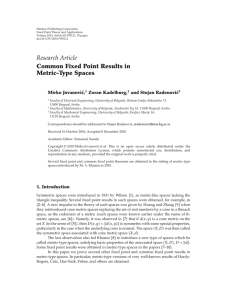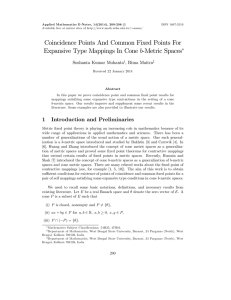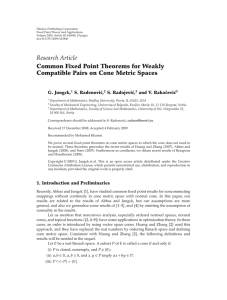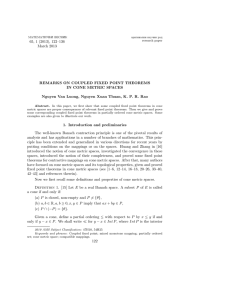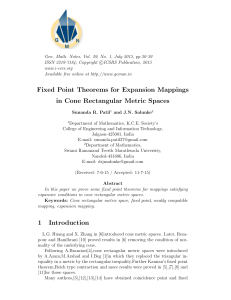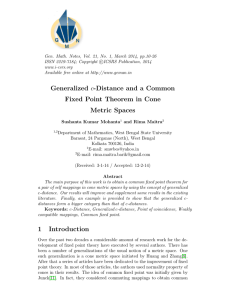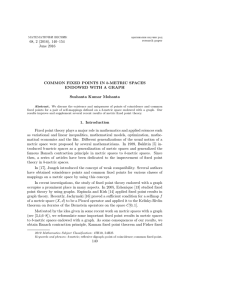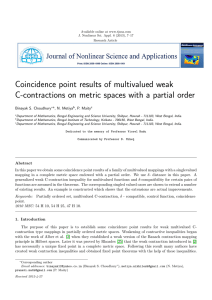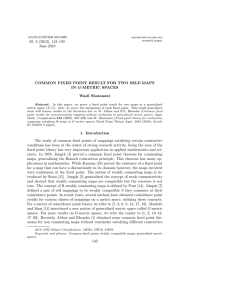Introduction and preliminaries
advertisement
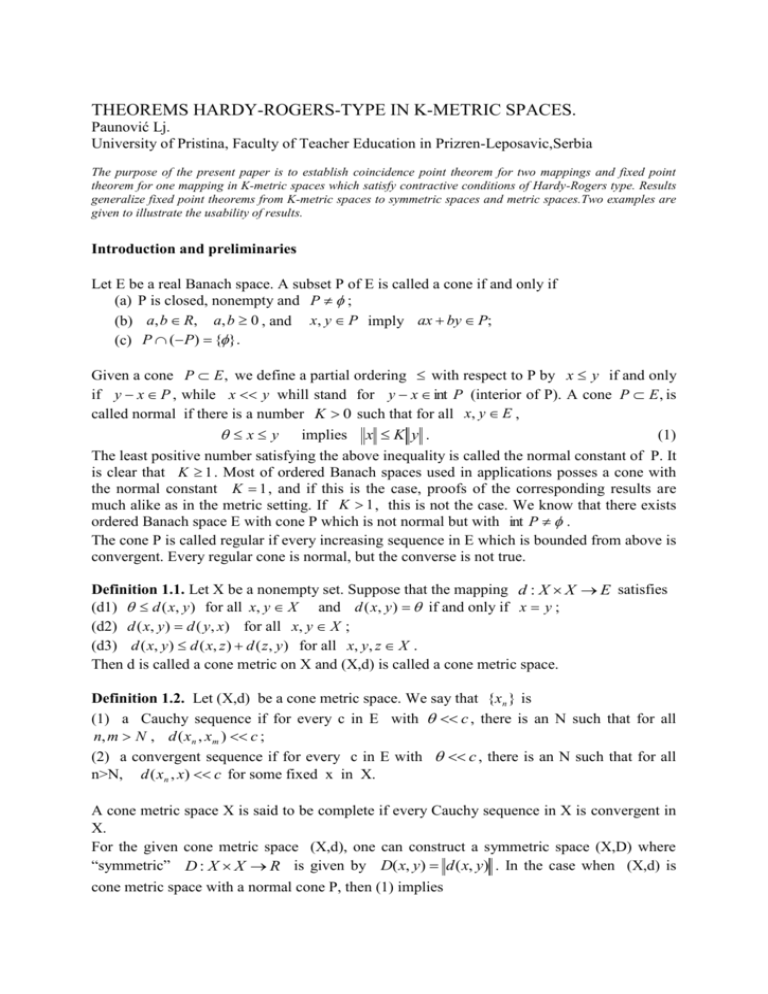
THEOREMS HARDY-ROGERS-TYPE IN K-METRIC SPACES.
Paunović Lj.
University of Pristina, Faculty of Teacher Education in Prizren-Leposavic,Serbia
The purpose of the present paper is to establish coincidence point theorem for two mappings and fixed point
theorem for one mapping in K-metric spaces which satisfy contractive conditions of Hardy-Rogers type. Results
generalize fixed point theorems from K-metric spaces to symmetric spaces and metric spaces.Two examples are
given to illustrate the usability of results.
Introduction and preliminaries
Let E be a real Banach space. A subset P of E is called a cone if and only if
(a) P is closed, nonempty and P ;
(b) a, b R, a, b 0 , and x, y P imply ax by P;
(c) P ( P) {}.
Given a cone P E , we define a partial ordering with respect to P by x y if and only
if y x P , while x y whill stand for y x int P (interior of P). A cone P E , is
called normal if there is a number K 0 such that for all x, y E ,
x y implies x K y .
(1)
The least positive number satisfying the above inequality is called the normal constant of P. It
is clear that K 1 . Most of ordered Banach spaces used in applications posses a cone with
the normal constant K 1 , and if this is the case, proofs of the corresponding results are
much alike as in the metric setting. If K 1 , this is not the case. We know that there exists
ordered Banach space E with cone P which is not normal but with int P .
The cone P is called regular if every increasing sequence in E which is bounded from above is
convergent. Every regular cone is normal, but the converse is not true.
Definition 1.1. Let X be a nonempty set. Suppose that the mapping d : X X E satisfies
(d1) d ( x, y ) for all x, y X and d ( x, y ) if and only if x y ;
(d2) d ( x, y ) d ( y, x) for all x, y X ;
(d3) d ( x, y ) d ( x, z ) d ( z, y ) for all x, y, z X .
Then d is called a cone metric on X and (X,d) is called a cone metric space.
Definition 1.2. Let (X,d) be a cone metric space. We say that {x n } is
(1) a Cauchy sequence if for every c in E with c , there is an N such that for all
n, m N , d ( xn , xm ) c ;
(2) a convergent sequence if for every c in E with c , there is an N such that for all
n>N, d ( xn , x) c for some fixed x in X.
A cone metric space X is said to be complete if every Cauchy sequence in X is convergent in
X.
For the given cone metric space (X,d), one can construct a symmetric space (X,D) where
“symmetric” D : X X R is given by D( x, y) d ( x, y) . In the case when (X,d) is
cone metric space with a normal cone P, then (1) implies
D( x, y) K D( x, z) D( z, y) ,
K is a normal constant of P.
x, y , z X
Definition 1.3. Let (X,d) be a cone metric space and P a cone with nonempty interior.
Suppose that the mappings f , g : X X are such that the range of g contains the range of
f, and f(X) or g(X) is a complete subspace of X. In this case we will say that the pair (f,g) is
Abbas and Jungck’s pair, or shortly AJ’s pair.
Definition 1.4. Let f and g be self-maps of a set X. If fx gx for some x in X, then x
is called a coincidence point of f and g, and is called a point of coincidence of f and g.
Self-maps f and g are said to be weakly compatible if they commute at their coincidence
point, that is, if fx gx for x X , then fgx gfx.
Proposition 1.1. Let f and g be weakly compatible self-maps of a set X. If f and g have a
unique point of coincidence fx gx , then is the unique common fixed point of f
and g.
Main results
Theorem 2.1. Let (X,d) be a complete cone metric space, P a normal cone with normal
constant K. Suppose that (f,g) is AJ’s pair, and that there exist nonnegative constants a i ,
i 1,5 satisfying
3
i 1
ai K (a4 a5 ) 1 such that, for every x, y X ,
(2)
D( fx, fy) a1 D( gx, gy) a2 D( gx, fx) a3 D( gy, fy) a4 D( gx, fy) a5 D( gy, fx)
Then, f and g have a unique coincidence point in X. Moreover, if f and g are weakly
compatible, f and g have a unique common fixed point.
Proof. Let x0 X be arbitrary and let x1 X be chosen such that y0 f ( x0 ) g ( x1 ) .
f ( X ) g ( X ) . Let
This can be done, since
be such that
x2 X
y1 f ( x1 ) g ( x2 ). Continuing this process, having chosen x n X , we choose x n 1 in X
such that y n f ( xn ) g ( xn1 ). We have to show that
D( y n , y n1 ) D( y n1 , y n ) for some [0,1), n 1.
(3)
From
D( y n , y n1 ) D( fxn , fxn1 ) a1 D( gxn , gxn1 ) a2 D( gxn , fxn ) a3 D( gxn1 , fxn1 )
a4 D( gxn , fxn1 ) a5 D( gxn1 , fxn )
a1 D( y n1 , y n ) a2 D( y n1 , y n ) a3 D( y n , y n1 ) a4 D( y n1 , y n1 )
a 5 D( y n , y n )
(a1 a2 Ka4 ) D( y n1 , y n ) (a3 Ka4 ) D( y n , y n1 ),
and from
D( y n1 , y n ) D( fxn1 , fxn ) a1 D( gxn1 , gxn ) a2 D( gxn1 , fxn1 ) a3 D( gxn , fxn )
a4 D( gxn1 , fxn ) a5 D( gxn , fxn1 )
a1 D( y n , y n1 ) a2 D( y n , y n1 ) a3 D( y n1 , y n ) a4 D( y n , y n )
a5 D( y n1 , y n1 )
(a1 a3 Ka5 ) D( y n1 , y n ) (a2 Ka5 ) D( y n , y n1 ),
we obtain
2D( y n1 , y n ) 2a1 a2 a3 K (a4 a5 )D( y n , y n1 ) a2 a3 K (a4 a5 )D( y n1 , y n ),
that is,
2a a a3 K (a4 a5 )
n 1,2,...
D( y n1 , y n ) D( y n , y n1 ),
1 2
1,
2 (a2 a3 K (a4 a5 ))
Further, (3) implies that
D( y n , y n 1 ) D( y n 1 , y n 2 ) ... n 1 D( y1 , y 0 ).
Now we shall show that
have
(4)
{ y n } is a Cauchy sequence. By the triangle inequality, for n>m we
d ( y n , y m ) d ( y n , y n1 ) d ( y n1 , y n2 ) ... d ( y m1 , y m )
Hence, as P is a normal cone, we have
D( yn , ym ) d ( yn , ym ) K d ( yn , yn1 ) d ( yn1 , yn2 ) ... d ( ym1 , ym )
K d ( yn , yn1 d ( yn1 , yn2 ) ... d ( ym1 , ym )
= KD( y n , y n1 ) KD( y n1 , y n2 ) ... KD( y m1 , y m ).
Now by (4), it follow that
D( y n , y m ) K (n 1 n 2 ... m ) D( y1 , y 0 )
Km
D( y1 , y 0 ) 0, as m .
1
From [1] follows that { y n } { fxn } {gxn1} is a Cauchy sequence. Since g(X) is complete,
there exists a q in g(X) such that y n q as n . Consequently, we can find p in X
such that g(p) = q. We shall show that f(p) = q. Substituting x = p, y = x n
in (2), we get
D( fp, fxn ) a1 D(q, q) a2 D( gp, fp) a3 D( gxn , fxn ) a4 D( gp, fxn ) a5 D( gxn , fp).
According to [1], it follows
D( fp, q) a1 D(q, q) a2 D(q, fp) a3 D(q, q) a4 D(q, q) a5 D(q, fp)
(a2 a5 ) D( fp, q) D( fp, q),
because a2 a5 i 1 ai K (a4 a5 ) 1. Now, if we suppose that fp q , then we have
3
a contradiction. Hence, gp = fp = q. We shall show that f and g have a unique point of
coincidence. For this, assume that there exists another point of coincidence q1 q in X such
that fp1 gp1 q1 . Now,
D(q, q1 ) D( fp, fp1 ) a1 D( gp, gp1 ) a2 D( gp, fp) a3 D( gp1 , fp1 ) a4 D( gp, fp1 )
a5 D( gp1 , fp)
a1 D(q, q1 ) a2 D(q, q) a3 D(q1 , q1 ) a4 D(q, q1 ) a5 D(q1 , q)
(a1 a4 a5 ) D(q1, q) D(q1, q).
As
a1 a4 a5 i 1 ai K (a4 a5 ) 1 , we get D(q, q1 ) 0 , that is, q q1 . From the
3
Proposition 1.1, it follows that f and g have a unique common fixed point.
Theorem 2.2. Let (X,d) be a sequentially compact cone metric space, P a regular cone and
f : X X a continuous mapping such that
(5)
d ( fx, fy) a1d ( x, y) a2 d ( x, fx) a3 d ( y, fy) a4 d ( x, fy) a5 d ( y, fx)
for all x, y X ,
where ai [0,1) , i 1,5 and
x y
5
i 1
ai 1. Then, f has a unique
fixed point.
In order to prove Theorem 2.2., we shall need the following lemma.
Lemma 2.1. Let (X,d) be a cone metric space, f : X X a mapping satisfying (5) for all
x, y X , x y where ai [0,1) , i 1,5 and
5
i 1
ai 1. Then
d ( f 2 x, fx) d ( x, fx) , for each x X with x fx .
Proof. Putting y fx in (5), we have
d ( fx, f 2 x) a1 d ( x, fx) a 2 d ( x, fx) a3 d ( fx, f 2 x) a 4 d ( x, f 2 x) a5 d ( fx, fx)
(a1 a 2 a 4 )d ( x, fx) (a3 a 4 )d ( fx, f 2 x),
that is,
a1 a2 a4
(6)
d ( x, fx) .
1 a3 a 4
By symmetry in (5), we have
(7)
d ( fy, fx) a1d ( y, x) a2 d ( y, fy) a3 d ( x, fx) a4 d ( y, fx) a5 d ( x, fy)
i.e., putting y fx in (7), we obtain
d ( f 2 x, f x) a1 d ( fx, x) a 2 d ( fx, f 2 x) a3 d ( x, f x) a 4 d ( fx, f x) a5 d ( x, f 2 x)
d ( fx, f 2 x)
(a1 a3 a5 )d ( x, fx) (a 2 a5 )d ( fx, f 2 x),
that is,
d ( f 2 x, fx)
a1 a3 a5
d ( x, fx).
1 a 2 a5
(8)
a a 2 a4 a1 a3 a5
k min 1
,
[0,1), then
1 a3 a 4 1 a 2 a5
d ( fx, f 2 x) kd( x, fx) d ( x, fx).
If
(9)
Proof of the Theorem 2.2. First, if u and v are two different fixed points of f,
according to (5), we have
d (u, v) d ( fu, fv) a1d (u, v) a2 d (u, fu) a3 d (v, fv) a4 d (u, fv) a5 d (v, fu)
a1d (u, v) a4 d (u, v) a5 d (u, v) (a1 a4 a5 )d (u, v) d (u, v).
This is a contradiction.
Let x0 X . We define the sequence x n f n x0 , n 0,1,2,... If xn1 xn for some n,
then x n is a fixed point of f. Suppose that xn1 xn for each n. Then, we have
d ( x n , x n 1 ) d ( f n x0 , f
a1 d ( f
n 1
a4 d ( f
n 1
n 1
x0 ) d ( ff n1 x0 , ff n x0 )
x0 , f n x0 ) a 2 d ( f
x0 , f
n 1
n 1
x0 , f n x0 ) a3 d ( f n x0 , f
n 1
x0 )
x0 ) a5 d ( f x0 , f x0 )
n
n
a1d ( xn1 , xn ) a2 d ( xn1 , xn ) a3 d ( xn , xn1 ) a4 d ( xn1 , xn )
a 4 d ( xn , xn1 ),
that is,
d ( x n 1 , x n ) d ( f
n 1
x0 , f n x0 ) d ( ff n x0 , ff n 1 x0 )
a1 d ( f n x0 , f
n 1
x0 ) a 2 d ( f n x0 , f
a 4 d ( f n x0 , f n x0 ) a5 d ( f
n 1
x0 , f
n 1
x0 ) a3 d ( f
n 1
n 1
x0 , f n x0 )
x0 )
a1d ( xn1 , xn ) a2 d ( xn , xn1 ) a3 d ( xn1 , xn ) a5 d ( xn1 , xn )
a5 d ( xn , xn1 ),
Now, we obtain
2d ( xn , xn1 ) (2a1 a2 a3 a4 a5 )d ( xn1 , xn ) (a2 a3 a4 a5 )d ( xn , xn1 ),
i.e.
2a a2 a3 a4 a5
a 1
d ( xn , xn1 ) 1
d ( xn1 , xn ) 1
d ( xn1 , xn ) d ( xn1 , xn ) .
2 a 2 a3 a 4 a5
a1 1
Hence, the sequence d n d ( xn , xn1 ) is strictly decreasing bounded below by . Since P is
regular, there is d * E such that
d n d * (n ). From the sequence compactness of
(X,d), there are subsequence { x ni } of {x n } and x * X such that
xni x * (i ). Since mappings f and f
2
are continuous, we have
fxni fx* and f 2 xni f 2 x* .
By using [1] , we have
d ( fxni , xni ) d ( fx* , x * ) (i ) and d ( f 2 xni , fxni ) d ( f 2 x* , fx* )
It is obvious that
(i ) and
d ( fxni , xni ) d ni d * d ( fx* , x* )
d ( f 2 xni , fxni ) d ni 1 d * d ( f 2 x * , fx* )
(i ).
(i ).
(10)
Now we shall prove that fx x . If fx x , then d 0. From (10) and according to
Lema 2.1., it follows
d * lim d ni 1 lim d ( f 2 xni , fxni ) d ( f 2 x * , fx* ) d ( fx* , x * ) d * .
*
i
*
*
*
*
i
We have a contradiction, so fx* x * . That is, x * is a fixed point of f. This completes
the proof of Theorem 2.2.
Literature
1. Huang L.G, Zhang X. Cone metric spaces and fixed point theorems of contractive
mappings, J. Math. Anal. Appl. 332 (2) (2007) 1468-1476.
2. Abbas M, Jungck G. Common fixed point results for noncommuting mappings
without continuity in cone metric spaces, J. Math. Anal. Appl. 341 (2008) 416-420.
3. Ilić D, Rakočević V. Common fixed points for maps on cone metric space, J. Math.
Anal. Appl. 341 (2008) 876-882.
4. Jungck G, Radenović S, Radojević S, Rakočević V. Common fixed point theorems
for weakly compatible pairs on cone metric spaces, Fixed Point Theory Appl. 2009,13.
Article ID 643840, doi:10.1155/2009/643840.
5. Kadelburg Z, Radenović S, Rosić B. Strict contractive conditions and common fixed
point theorems in cone metric spaces, Fixed Point Theory Appl. 2009, 14. Article ID
173838, doi:10.1155/2009/173838.
6. Kadelburg Z, Radenović S, Rakočević V. A note on equivalence of some metric and
cone
metric
fixed
point
results,
Appl.
Math.
Lett.
(2010)
doi:10.1016/j.aml.2010.10.030.
7. Radenović S, Kadelburg Z. Quasi-contractions on symmetric and cone symmetric
spaces, Banach J. Math.Anal. 5 (1) (2011) 38-50.
8. Nemytzki V.V. Fixed point method in analysis, Uspekhi Mat. Nauk 1 (1936) 141-174.
9. Edelstein M. On fixed and periodic point under contractive mappings, J. Lond. Math.
Soc. 37 (1962) 74-79.
10. Djukić D, Paunović Lj, Radenović S. Convergence of iterates with error of uniformly
quasi-Lipschitzian mappings in cone metric spaces, Kragujevac J. Math. Vol.35,
3(2011), 399-410.
11. Filipović M, Paunović Lj, Radenović S, Rajović M. Remarks on “Cone Metric Spaces
and Fixed Point Theorems of T-Kannan Contractive Mappings“, Math. And Computer
Modeling, vol. 54, Issue 5-6, September 2011, pages 1467-1472.

